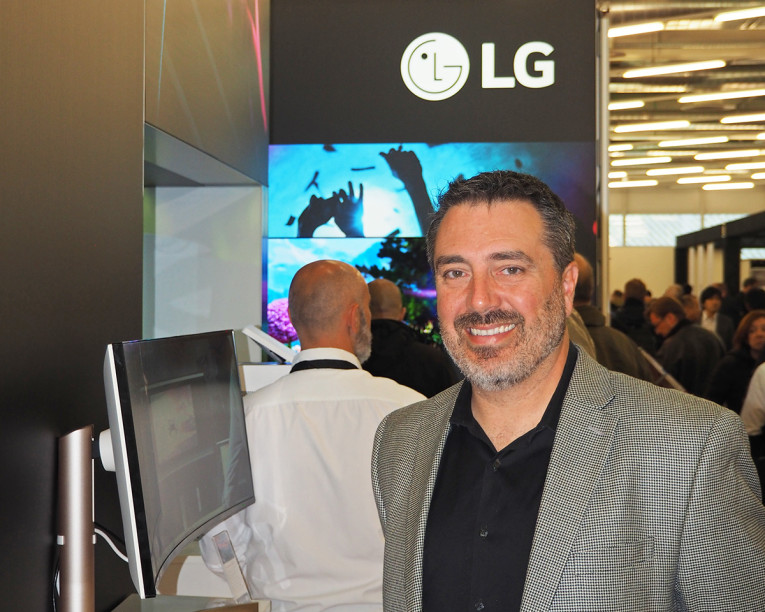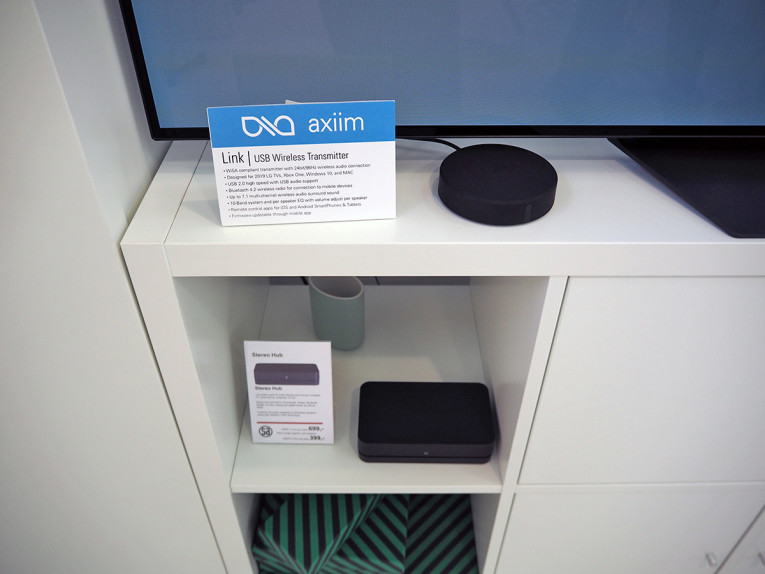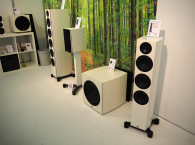
As audioXpress has been extensively reporting, the WiSA momentum has never been greater, and the increasing number of new company members joining the association is increasing exponentially. Especially since the collaboration with LG Electronics was announced just prior to CES 2019. The full promise of a home theater system with simplified wireless audio, was fulfilled in this collaboration, putting LG Electronics' latest range of OLED and NanoCell TVs at the center of a solution that can dramatically increase the enjoyment of TV, streaming content, movies, gaming, music, and more. LG's 2019 OLED and Nano Cell TV series all now support WiSA, are compatible with WiSA USB Transmitters and a full range of intelligent WiSA Certified speakers already on the market.
audioXpress caught up with Tony Ostrom, president of WiSA, at the recent Munich High End show, where the association, Summit Wireless Technologies - the technology arm and WiSA founder - and LG announced the next step in its global collaboration, and signaled the European launch of the WiSA Ready initiative. Explaining better, WiSA Ready TVs, gaming PCs, and console systems are "ready" to transmit audio to WiSA Certified speakers when a WiSA USB Transmitter is plugged in and a user interface is activated through an APP or product design (e.g., LG TVs). The combination offers easy connectivity to external wireless speakers with very low latency to WiSA Certified intelligent speakers.
At the High End 2019 show, several WiSA members were supporting LG's demonstrations with new WiSA Certified speakers, including Klipsch, Harman, and newly certified models from System Audio, and Electrocompaniet's latest EC Living Wireless Lifestyle Series.

audioXpress : Tell us about your recent experience with LG Electronics and what brought you to High End.
Tony Ostrom: A couple of our members are showing new products, and with the WiSA Ready momentum and LG launching its 2019 TVs, we were able to make those connections, so we have a couple of speaker brands here that are actually showing LG TVs in their booths - connecting to their WiSA Certified speakers. As LG is releasing the 2019 products, it's nice that the speaker companies are aligning with them and their marketing strategy. This is a great opportunity to show what the solution can do, how easy it is to connect the system, what the performance can be, right after the launch. We didn't have to wait a long time. Everything seems to be aligned in North America, Europe, and Asia, creating a perfect opportunity for companies to show what WiSA is doing.
LG are extremely strong supporters. As they are going into their training season, they want to make sure that they are telling the right story, and that they are able to promote the capabilities of the TVs properly and aligning with speaker brands. They have been excellent partners.
AX : Do you expect to have similar traction with other TV manufacturers?
TO: Yes. We've had discussions with other TV manufacturers. And we anticipate additional source manufacturers to join as well. Those should be announced by the next CES timeframe. And I anticipate there will be more brands in 2020, which is great for everybody, because it tells the story and it helps with the standard. LG is certainly first and is showing what's possible and how cool it can be.
The future is the content coming from that glass panel that fits in my pocket, fits on my desk, or fits on my wall, and easy distribution of sound to speakers, wirelessly. Wirelessly to my headphones, wirelessly to my speakers on my desk, or wirelessly to my home theater system. And how easy it is to setup and to expand. WiSA is doing the part that works with home theater. We are the part that's multichannel, low latency, all those things.
And coming directly from the panel is the most elegant way to do it. And for all speaker partners not needing to build the transmitter side... The panel guys are becoming pretty much the content streaming, the aggregation and the control mechanism, so they can just send the audio and we will take care of the rest. That paves the path for the rest of the industry really.
And that's not just TV... It's gaming systems, PCs, set top boxes, anything that's bringing content in and WiSA ready, and with a USB output allows you to have a solution ready.
AX : So, apart from WiSA Certified products, you now have a WiSA Ready program?
TO: Yes. We're in the process of putting together a specific certification just for WiSA Ready solutions. It had been part of the greater documentation, but with such an interest now, that is for those types of partners where we can simplify it. This will help them through the process and get more products certified. It's very cool to walk into retailers and see the WiSA logo on LG boxes, I'll tell you that!
AX : That will certainly help to finally create the public awareness that WiSA needs. But, will it help clear the noise that for a while was generated on the topic of wireless audio, with supposedly multiple competitors?
TO: Yes. That has consolidated a bit. The leaders are really starting to be set. And the other thing is, it was never really what we were doing. Before this opportunity, I was in product development, and we were doing all the research and trying to figure out which path to take. We were looking at the Play-Fis and the Qualcomms and all the others, and back a few years it was mainly about "What are we going to do to compete against Sonos?". It was always whole-house first, and then an extension to rear speakers or something. It really wasn't multichannel home theater. Maybe surround on a soundbar. And that's fine for certain applications, but we are talking being in that room in your house where you sit down and enjoy surround sound content, multichannel. That's what we're talking about.
If in some of your rooms you have a soundbar and a sub, that's great, and it's not that we cannot play there too, but our real advantage is when you start talking about high definition, 4, or 5, 6, 7, 8 channels of audio, and there really wasn't and there isn't a competitor there.
When I see the conversation we are having with other WiSA members and other speakers manufacturers, everyone is telling us that it's great that we are doing this. There's a feeling of unity and a movement which I think everyone's been wanting for a while. We are really starting to get traction in that area and it's really exciting.

AX : But isn't WiSA going to get to a point where you have to decide what, if anything, you are going to do with multi-room?
TO: I guess there's two different parts to the answer.
One is that right now we are focusing on multichannel, single room. But we're also making sure that we play nicely with all those other technologies - whatever you're using to bringing content in. Products that are in the market, or are coming to market that do that. The Harman Citation products are an example. They are WiSA Certified, and they use another technology to bringing content in, and we can distribute it.
Playing nicely with those guys is a priority.
Then, the other thing is that obviously there will be evolutions of what we're doing. We are constantly trying to figure out how to make things easier. If you look right now at personal audio, it's Bluetooth. If you look at distributed audio, it's Wi-Fi. And if you look at home theater audio it's WiSA. Those things will start to merge.
I can't go into more detail.
There's definitely a roadmap.
At the end of the day, we are constantly looking at what is the benefit for the consumer. How to make their lives easier.
The other important thing is productizing in a usable, thoughtful way and making it as turnkey as possible to implement it and get it up and running.
We are ready to support our members with development, show them samples and things that work. That helps a lot. Not just having a technology that works, but actual examples of a finished product.
We just want to facilitate, getting signals from one place to the other without messing it up, and help those companies bring those products to market and utilize it and make sure that it's all interoperable. That's the goal.
AX : Is high-resolution audio still an argument for wireless audio, and a key differentiator for WiSA?
TO: We transmit at 24/48 or 24/96, with all channels driven and with 5.2 or 2.6 ms depending on whether you are at 96 kHz or 48 kHz and with synchronization well within a sample. The point is, it's already so good, that I think we don't have to get extreme. It's my personal take on that.
It's not the key selling argument.
There are certain steps that you would think are fairly basic, but aren't still being taken in a lot of situations. Good quality 5.1 is still pretty awesome! Now, if you can add elevation speakers and a second subwoofer that's all great... With all the content coming in now that's multichannel, just getting a 24/48 or 24/96 program, with speakers behind you, maybe elevation, that's a phenomenal system.
But it's pretty rare still... and if we can help people realize how great that can be, we will be a lot better off.

AX : What is the role of Summit Wireless Technologies, the company, and WiSA as an association? How do the two interconnect?
TO: What Summit is doing on the silicon side, at a technical level, together with partners and lead users, on the development side, as well as the brands, is to bring those worlds together. It is all about aligning these different roadmaps. The tech roadmap with the product roadmaps. And these are different companies.
It's the providers of the technology dealing with the guys that are actually productizing it and having conversations to make sure that everyone is walking down the right path, because, it's not a formal development cycle. We've got to know what's going on in 2021 and 2022, and those conversations are happening.
So that's important.
I always believe in having a tech roadmap, a product roadmap and kind of a line plan. The line plan is what's actually happening, and we are sure of it. The product roadmap is all the things we are working on. And the tech roadmap are the concepts that can maybe fall down into the product roadmap.
Aligning that when we are dealing with multiple different entities is complicated. But Summit is all over it.
It's cool. When I am in those calls and I see who they are working with, we can see it's a solid plan. But we present it in a unified front, with technology and brands. Everything is very well-thought-out. At the same time, WiSA as an association, makes sure that the solution is implemented in an interoperable way that allows all our members to easily contribute and be part of the category.
AX : Is WiSA going to expand into the mobile space as well?
TO: We believe in having as many different sources as possible. Anything that is bringing in content and has the ability to wirelessly distribute it. Same with VR. The solutions are out there, and we will see how it works. And gaming is getting bigger and bigger. Gaming is different from movie audio, which is multichannel and it gets produced one time. In a game, it's all based on user input... But the audio is still multichannel and it's phenomenal. It just needs to be rendered instantaneously based on user input. For all those applications you need to have a great playback system. And it needs to be easy to setup, reliable, and very high definition. I think those are huge opportunities. aX
This article was originally published in The Audio Voice newsletter, edition 230, May 30, 2019. The Audio Voice is the weekly newsletter for audioXpress and Voice Coil magazine communities. Subscribe here.







